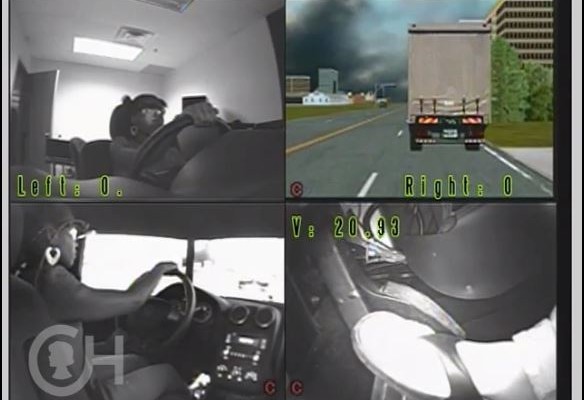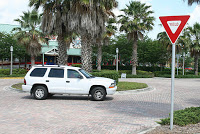Tag Archive: driver education

Newly Licensed Teens Lack Safe Driving Skills
June 11, 2015
Many newly licensed teen drivers lack the driving skills to drive safely according to a study sponsored by the Children’s Hospital of Philadelphia (CHOP) and published in the journal Injury Prevention.
It has long been known that a teen driver’s chances for being involved in a crash are greatest within the first three months after receiving their license. Even though they’ve passed their driving test and received a license, they lack the experience and training to recognize hazards ahead. State driving tests don’t have the capabilities to evaluate teen drivers under “real time,” hazardous road conditions.
Image courtesy of Insurance Institute for Highway Safety
The study compared teen drivers who had been licensed for less than three months with adult drivers who had more than five years driving experience and no crashes within the previous three years. Participants were evaluated in driving simulators that were programmed with 22 driving scenarios, each of which had the potential for a “negative outcome.”
In the study, 43 percent of the teen drivers experienced at least one simulated crash compared with 29 percent of the more experienced adult drivers. According to the researchers, the most common types of crashes involved left turns, rear-end events, and running off the road. For every error a teen driver made during the simulation, their chances of crashing or running off the road increased by eight percent.
While the newly licensed teens exhibited good basic driving skills such as choosing the proper lane, stopping for red lights, etc., they seemed to have difficulty when it came to recognizing, responding to, and braking for potentially hazardous situations.
Most states don’t require behind the wheel training in their teen driver education programs. Most states leave the behind the wheel driver education to their parents and those parents rarely have the training to properly teach the teen how to drive safely. Driver education programs that use driving simulators can be effective in teaching teens to anticipate and properly respond to a hazard in time to avoid a crash.
The videos below show three of the typical hazard scenarios where newly licensed teens failed to anticipate trouble ahead.
Read more: Many Newly Licensed Drivers Don’t Know How To Drive

10 Most Confusing Traffic Signs
December 27, 2011
We all know that traffic signs do an important job: they tell us what exactly we can or can’t do on the road. But what if the signs were confusing? Sometimes this leads to funny stories afterwards, other times it leads to tragedy, as a misunderstood sign may sometimes lead to crashes.
These signs, wherever state they may show up, must be approved by the Manual on Uniform Traffic Control Devices (MUTCD). They create the standard by which all signs could be installed, maintained, and managed by road managers everywhere. The MUTCD is published by the Federal Highway Administration (FHWA).
Here then, is a list of some of the more … confusing traffic signs that are currently out there.
Yield – The red upside-down triangle sign, or sometimes, a simple verbal instruction to “YIELD”? It’s surprising just how many people get confused with this sign. The best way to describe it is it’s like a lighter version of the STOP sign. When faced with this sign, motorists should stop, give way to vehicles from another approach and then enter an intersection. These usually appear in smaller roads that don’t get enough traffic that they don’t necessarily need a STOP sign.
Runaway Vehicles Only – But what if you weren’t running away? This sign signifies that a runaway device is installed in an area. This is usually for trucks that have lost control — the device is usually a patch of road with sand or gravel, which helps vehicles come to a safe stop. The gravel or sand allows the momentum of the big vehicle to dissipate, allowing for safe stopping.
This Side of Sign – This sign signifies that something is allowed on “this side” or the side where the sign is installed. A variation of this sign may say “Parking This Side of Street.” This means that one may only park on that specific side and parking elsewhere may give you a parking ticket.
To Request Green Wait On [Bicycle symbol] – Blame it on confusing wording. This sign is supposed to give bikers a green light. This sign should be used in conjunction with traffic actuators that are adjusted to the amount of metal a bicycle has. If you’ll notice, there is a vertical line going on the top and bottom of the bicycle symbol. This means that bikers should position themselves in the designated marking for them to be detected by the actuators, giving them a green light. Some people confuse this as waiting for bicycles to ride by until they can get a green light.
Look <—-> – Looking left-to-right? Isn’t that what parents and preschool teachers teach kids before crossing the road? This sign is usually located near railways, signifying that motorists should be on the lookout for trains from both directions.
Truck Rollover – Nope this sign doesn’t signify the truck-wheelie lane — it only means that there is a slope nearby that truck drivers should be aware of, since there’s a big tendency for their vehicles to rollover.
Circular Intersection – Though it bears a striking resemblance to the recycling sign, this sign simply signifies that a circular intersection is coming up. Some circular intersections are different. In some cases, the entering vehicles have the right-of-way, while the vehicles inside the circle must yield. Sometimes this is reversed, so drivers have to do a bit of research before they go right through.
Stop Ahead – Stop vertically? No — this is simply a sign that signifies that there will be an oncoming stop. A sign for a sign, perhaps?
9% Grade – The roads aren’t trying to quantify your reading level or your abilities with math. This only means that there is an oncoming 9% Grade slope. Slopes on the road are measured in grades: consider that 9% is 9-feet off a hundred. It means that elevation may change from 5 (5% Grade) to 9 (9% Grade) feet.
DIP – Motorists have to wonder: how exactly are they going to “dip” their cars? This simple sign that says “DIP” means that there will be a dip in the road: parts of the road may go down, and then elevate right back up again.
Having trouble with learning the Roads of the Road and Traffic Signs? Take a DMV Practice Test to become an expert and pass your DMV written exam the first time.

Five Important Reminders for Teen Drivers
January 3, 2011
Teaching teens how to drive is only the first step of becoming a safe driver. To become confident and competent behind the wheel it is important that they learn defensive driving strategies. Whether they have just received their license or have been driving for a year, defensive driving school is an opportunity to brush up on the rules of the road. Even though teens as new drivers are starting off fresh, as new learners, sometimes they need a little reminding.
Here are five important reminders for teen drivers:
- 1. Failing to prepare is preparing to fail. Surveys conducted by several driving safety organizations have yielded the same result: teen drivers think that they are better drivers than other drivers. Preparing to drive means preparing the vehicle for safety and mentally preparing the driver to be focused on driving, and nothing else, when a teen driver gets into the driver’s seat.
- 2. Seeing signs. Ever notice those things by the side of the road sometimes? Those are meant to be followed. Speed limits are put into place not by some arbitrary decision: road engineers have taken the time to study traffic flow in an area to determine by which speed it is best to drive at.
- 3. Undertakers love over takers. It’s easy for a teen driver to lose his or her cool when another driver cuts them off, or overtakes them. Some motorists go so far as driving fast to catch up to the drivers who did it to them. Simple advice: let them go on. It’s not a race and it’s not worth the risk of a ticket or crash.
- 4. Distraction is two letters away from destruction. A teen driver may feel that they can ABSOLUTELY do something else while driving, while statistics and surveys often prove otherwise. Surprisingly, teen drivers fail to acknowledge that having other teens in the car is one of the biggest distractions from driving. Eat/text/call/change tunes BEFORE starting the car.
- 5.Drinking, drugging and driving DO NOT mix. That goes with prescription drugs and over-the-counter medications that may impair driving ability too. Teen drivers often underestimate the effects of alcohol, and what they don’t know is, when they get a DUI, it haunts them for a long time. It follows them when they look for jobs; apply for scholarships or when they are going to pay for car insurance. Not to mention that it also puts themselves and other motorists at risk.
If you area teen or know a teen, share these important reminders for safe driving, Driver education is continuing education, especially during the teen years.

Driver’s Ed is Not a One Shot Deal
September 1, 2010
Working in the driver safety field for over a decade, I find myself giving parents both solicited and unsolicited advice. I am passionate about teen driver safety, not only because I was a teenage driver at one time and made irrevocable mistakes along with many of my friends, but also because I am a parent who is concerned about my own teen drivers and their friends on the road.
Driver ed is not a one time deal. From the ages of 14 to 19, parents need to approach driver training as driver continuing education. Aspects of continuing education include: safety awareness, prevention education, introductory teaching, skill development, intermediate education, additional driving exposure and defensive driving education. The Governor’s Highway Safety Administration (GHSA) and many individual states are aware of the importance of continuing driver education. As parents, it is time that we change our attitudes and recognize the value this type of training provides.
By the time a soon-to-be driver is 14, they realize that it won’t be long before they are behind the wheel. They become more aware of how you, your family members and other adults they travel with drive on the roads. They notice when you speed, try to multi-task, weave in and out of traffic, try to beat the red light and fuss about other drivers.
From this point, driver training has begun. If you haven’t already started being a positive role model, the time has come to do so. This is a good time to:
- Brush up on the state’s driving manual
- Discuss the precautions you take when deciding what time to leave, routes to go and lanes to travel in and how those precautions change based on circumstances
- Discuss current driving related articles in the news and prevention strategies
Prior to applying for your learner’s permit, Florida law requires completion of the Drug and Alcohol Class, which is a 4 hour course that focuses on prevention. Two-thirds of the curriculum generally addresses the dangers of drugs and alcohol and how deadly they become when combined with driving. The remainder of the curriculum addresses:
- Following distances
- Stopping distances
- Special vehicles
- Different aspects of the driving environment
It can be done in a classroom setting with an instructor or online at their leisure.
At this point, your teen hasn’t even started the vehicle and quite a bit of education has already begun. This is a great time to create a Parent-Teen Driving Contract, which will establish the boundaries, responsibilities and privileges of driving during their teen years. Also keep a driving log; to keep track of the amount, type and time of day that driver training was conducted.
Once the new driver has passed the road signs, regulations and eye tests, they will be issued a Learners Permit from the Division of Motor Vehicles. As a parent, you can now begin some introductory teaching:
- Show them the equipment, gauges and their functions on the interior and exterior of the vehicle.
- Begin very simple skill development regarding pre-trip inspections, starting, stopping and parking.
The next step is to move into intermediate education and intermediate skills. You may want your teen to take a driver’s education class or practice with an instructor. If you plan to take on the instruction yourself, it should be during this stage that you dedicate time (most states require 50 hours supervised) exposing them to highways, specific weather conditions and driver safety practices such as how to properly use the vehicle mirrors.
Practicing these intermediate driving skills help the new driver develop an adequate understanding of the vehicle and the skills to maneuver it with confidence. This is the time to discuss what it means to be a safe driver. Some topics to consider:
- What type of driving behaviors do safe drivers demonstrate?
- What type of attitudes do other drivers bring behind the wheel?
- How should a safe driver respond to harried, angry, or inattentive drivers?
- How important is being rested to making safe driving decisions?
As you move into the next stage of driving, your teen driver should demonstrate control of the vehicle. You should feel confident in their judgment and how they handle most driving situations. Focus on refining their skills by exposing them to complicated driving scenarios and employing defensive driving strategies such as:
- How to handle multiple hazards
- Identifying hazards with the greatest priority
- Which escape routes are available
- Complex right of way situations
Walk through vehicle emergencies, not only handling their vehicle, but also how to respond to another vehicle experiencing an emergency such as a blown tire.
Enroll your teen in a defensive driving class either right before they get their license or soon afterwards. While they may know how to drive, they haven’t been ready to fully understand defensive driving techniques for themselves. Don’t wait until something happens that requires them to take a class.
Because teenage drivers are most at risk of a crash during their first year of licensure, there are supplemental classes they can take. Some courses are only one hour and include topics such as:
During that first year, it is important to phase in how much access to the vehicle they have, the time and under what conditions they drive, and the number of passengers, if any allowed.
Driving is such an important step in a teen’s development, but it can also be very dangerous. It is up to the parents to establish and enforce a strong graduated licensing system. Remember that driver education is ongoing over the teenage years.
Driver education is continuing education.

Driver Education Information That Could Save Your Life
May 21, 2010
Driver education can save thousands of lives. Don’t believe me? Imagine a car and a gun side-by-side. Tell me, which do you think has taken more teen lives? If you feel like the answer should be the gun, think about this for awhile: which one of the two do you see more often day-to-day? While most of the country pays close attention to the subject of gun control or the views of the National Rifle Association, very little focus is given to the number one cause of death for teens- Car Crashes.
The need for driver education is very important because so many of us take the right and the responsibility of driving every day for granted. We travel the roadways and go about our daily routines without the safety reminders we all need. And if you are a new driver— you need the reminders more frequently. We’re going to discuss the basics — the lessons you should be absorbing. This is by no means a substitute for actual driver education, just a summary of the information you may need a refresher on and could save your life.
Buckle Up – Before even starting the car or stepping on the accelerator, always fasten your seat belts. Each year, over 400,000 teen drivers between the ages 16 and 20 get injured in car crashes. Wearing your seat belt will help save your life. It will keep you from being thrown out of the vehicle, lessen the force of impact when hitting the dashboard or other interior spaces in the vehicle and reduce the collision forces on your internal organs. Coupled with air bags, what would be a fatal crash can be reduced to one with only minor injuries. This is also true for your passengers. Make sure they fasten their seat belts. In the event of a crash, if they are not properly belted they can literally become a flying object within the car causing serious injury themselves and other occupants.
Overcrowding – When driving a car, you are not only responsible for your safety, but also for the safety of all your passengers. Being a teen driver already increases your crash risk, but having other teens in the vehicle actually doubles that. Teens make up about 12% of all fatal car crashes in the United States. Overcrowding not only affects the way you drive overall, but causes distractions while driving. In some states, you can be ticketed and fined for driving with minors in the car.
Overloading – A fact you learn in driver education: for every 100 pounds in the car’s trunk, we lower the car’s fuel economy by 2%. This may seem like a low number, but it adds up in the long run. Not only that, but it shifts the center of gravity of your vehicle which in turn affects engine performance, braking distance, and how the vehicle reacts in an emergency. If you’re planning on carrying a lot of stuff — don’t stuff it in the trunk, call a moving van instead.
Emergency Kit – Driver education teaches you all aspects of driving: from trip preparation, operating a vehicle, laws and safety guidelines, defensive driving techniques and handling vehicle emergencies. Always make sure that, when faced with a vehicular emergency, breathe — stay calm. Panicking does not fix your car or improve the situation. If you plan ahead with the proper knowledge, a vehicle emergency tool kit including a spare tire, you’re going to be okay. If you can’t fix the vehicle, remember to have a fully-charged phone, with all your emergency numbers before leaving.
Car Maintenance – Do you know how to check your oil? Is there enough fuel in the tank? Can you check if your tires are worn? Can you check the tire pressure? Are your mirrors adjusted correctly? These are small things you should know how to do after attending driver education — and you should turn this into a routine!
Defensive Driving Techniques – Do you know where your blind spots are and check them each time? Do you keep a space cushion around your vehicle? Is there always a minimum of a two second following distance between your vehicle and the one ahead? Do you look left right left again before entering and intersection? These are some of the many techniques to be a defensive driver and a driver education course covers them.
Driver education is a small step for turning teens into competent drivers on the road. Not only that, but driver proficiency is a skill you will be carrying for life — knowing the small things could save your life in the future! If you have a good attitude towards learning, and you try to learn as much as you can, you are well on your way to becoming a great driver.
